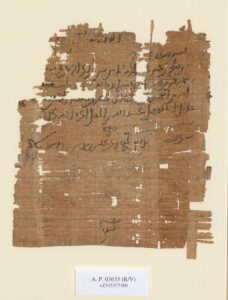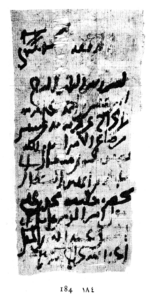Next week, the Caliphal Finances team will welcome Matthew Gordon and Eugénie Rébillard to discuss their respective research and share the Caliphal Finances team’s recent work, focusing in particular on the second half of the ninth century. To prepare for this, I (PostDoc Noëmie Lucas) have been focusing on this period in my reconstruction of the list of fiscal officials in Egypt. This blog mentions one of these officials, recorded only in documents (as far as I am aware), and addresses some issues relating to the reading of papyrus that collaboration with PostDoc Eline Scheerlinck helped resolve!
The governor appointed in Egypt from 856 until 867, Yazīd ibn ‘Abdallāh al-Turkī, was not in charge of the kharāj. During his ten-year tenure, we know of a number of aṣḥāb al-kharāj, some of whom are quite well known, such as Sulaymān b. Wahb, and, near the end of Yazīd’s governorship, Ibn al-Mudabbir. Early in Yazīd’s tenure, the name of Abū al-Faḍl ‘Ubayd Allāh b. al-Ma‘lā or al-Mu‘alla is found in two papyri: CPR XXI 54 and P.Cair.Arab. 184. Both documents are tax receipts, and in each Abū al-Faḍl is the last official mentioned in a list that includes other officials like the qusṭāl, a representative, and one or two fiscal officials with the title ‘āmil. In both cases, Abū al-Faḍl’s name is followed by the honorific phrase a‘zzahu llāhu, indicating that he held the highest rank in the fiscal hierarchy among the officials listed in each papyrus.

CPR XXI 54 verso. Tax receipt in the collection of the Austrian National Library Vienna
CPR XXI 54 is dated to 243/857-858 by Greek numerals, as seen in line 8 of the papyrus. As for P.CairArab. 184, Grohmann, who edited the papyrus, read the Greek numerals in the last line as 249/863-864. While the first date aligns with my chronology of fiscal administrators in Egypt in the Abbasid period, the second, which would be six years later, is questionable. The primary reason is that, by 249, the ṣāḥib al-kharāj of Egypt was known to be Ibn al-Mudabbir, who was appointed in 247-8 (as rightly pointed out by Ahmad Kamal). While it is possible that two officials held the position simultaneously, as we have other instances of apparent dual leadership in the fiscal administration, a second reason supports the first one. It comes from the papyrus itself. Despite the poor quality of the image, Eline Scheerlinck’s analysis of the Greek numerals allowed us to interpret them differently and redate the papyrus to 243/857-858.

P.Cair.Arab. 184. Image from the edition: Arabic Papyri in the Egyptian Library, ed. A. Grohmann. Cairo. Plate XVII
Both CPR XXI 54 and P.Cair.Arab. 184 show a similar way of writing the final number, with an extended gamma marked by a horizontal line (see caption). This correction aligns our chronology and confirms Abū l-Faḍl’s active years.
So far, I only know Abū l-Faḍl from these two papyri, and he is not the only fiscal administrator known solely through documents; another example is Sa‘īd b. ‘Abd al-Raḥmān, who was active between 223-227/838-842. This post highlights the importance of examining papyrus editions alongside their images whenever possible, the invaluable nature of collaboration, as I would not have been able to analyse, compare, and read Greek dates in various papyri alone, and, finally, the time required to ascertain information, such as an official’s tenure, whether through literary sources or documents.
Arabic documents are cited according to “The Checklist of Arabic Documents”.
Banner image: Pieter Breughel the Younger, The Tax Collector’s Office (c. 1615), Art Gallery of South Australia.
This blog has been written by Noëmie Lucas and Eline Scheerlinck.






Leave a Reply